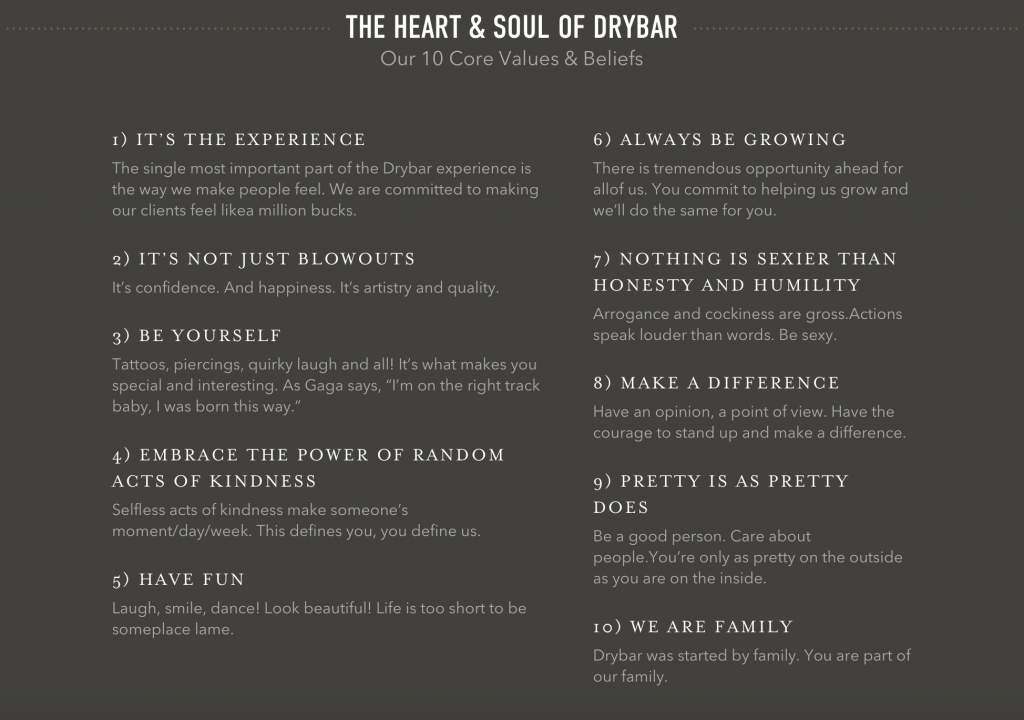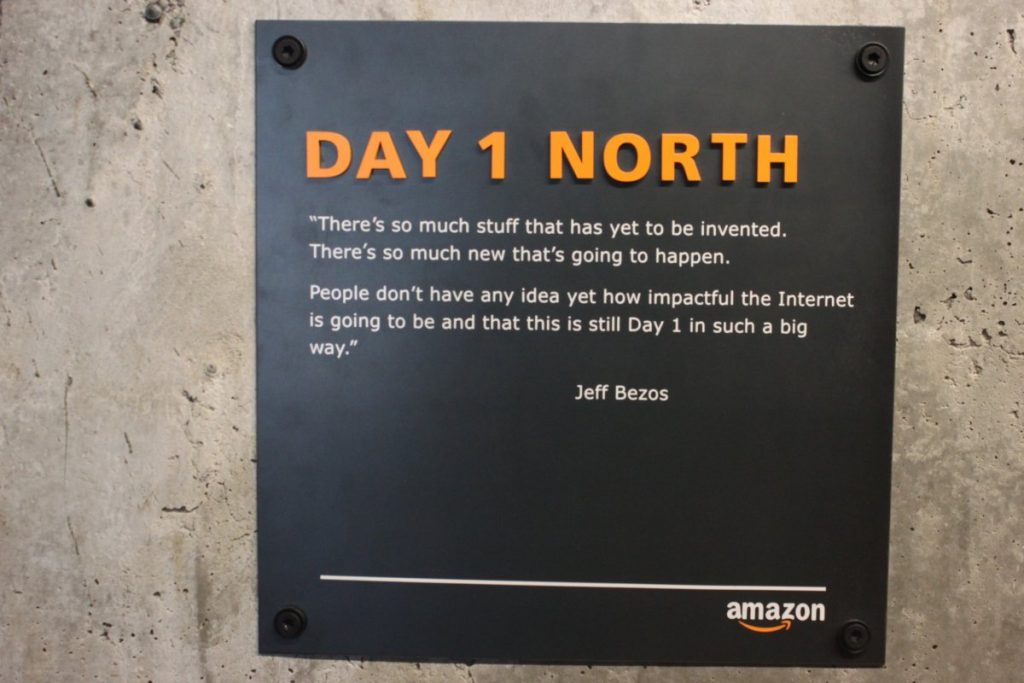Dogma Whisperer
What is your company’s dogma?
Performance with Purpose (PepsiCo). Deliver Wow (Zappos). Entreocracy and Take Extreme Ownership (Indinero). Pretty Is As Pretty Does (Drybar). Move Fast and Break Things (Facebook). Never Stop Exploring (North Face).


Powerful stuff. These doctrine principles can define a company, brand, and team culture. They can motivate your employees to stretch further and push forward amidst challenges. They serve as little reminders and can be soul boosters.
Something that we always do with all clients and incubees when we set out to do a planning session is outline their mission, vision, and values. This is critical to grounding the conversation and ensuring that plans are founded upon the brand’s core values and purpose. Brand manifestos can be useful, and there may be some crossover between the external brand manifestos and internal employee creeds.
When you are building your company, you may also develop these dogma-like philosophies to run your business and to share with your team. They can be incredibly inspiring and also reinforce your team decisions and actions, both small and big on a daily basis.
So how do you pen a guiding approach to capture the heart and spirit of the company to embody the beliefs and values of the company, all in an imaginative and inspiring way?
- Start by ideating with some key exercises:
- We believe….
- Imagine a world where….
- We exist to….
- We are passionate about….
- Everyday we…
- We will show the world….
Also reflect on why you started the company and the original founder story.
- What was your mindset, energy, and attitude at that moment?
Think about your consumers and the brand architecture and brand strategy.
- What is the spirit and personality of your brand? How can you incorporate that into your dogma?
Consider the areas that you wish to avoid.
- What are the pitfalls and blind spots that you want your team to avoid?
Don’t forget that you want to invoke a response. It’s okay to create a provocative statement that stimulates a movement or unifying cry.


Our holding company CEO Julia Huang has developed a bold philosophy called 60/40. We have a huge neon art installation in the office to prove it. The 60/40 idea is a mindset that is intended to embody our daily work life, spirit, and way of thinking. Basically it means that while you have obligations to deliver work and the normal grind for 40% (in terms of time, of work, of headspace, of goals), you have permission to stretch beyond the status quo for the other 60%. The 60/40 rule is different for everyone depending on their role in the company, and it isn’t meant to be something to take literally. For example, we’re not saying to go to the beach for 3 days of the week. But instead, it is a driving force to shape your energy. While our company culture is set up to be a “Culture of Opportunity,” we found that sometimes the notion is too ambiguous. So, the 60/40 mindset demonstrates to people to spend 40% of their time making clients happy and 60% thinking about and doing what should be the right thing to do for the client, finding how to make co-workers lives easier, and focusing on what they really want to work on. We all know that there are the mandatories and deliverables, but what else is there — to allow unbridled passion projects, to imagine new possibilities, to flex new muscles, to push breakthrough thinking, and to drive innovation.
I recently was reading about how Jeff Bezos, for the last couple of decades has lived by the philosophy that Amazon is operating at “Day 1.” In fact, he has a building on campus called Day 1. What does this concept of Day 1 mean exactly? According to Bezos:
“Day 2 is stasis. Followed by irrelevance. Followed by excruciating, painful decline. Followed by death. And that is why it is always Day 1.”
To be sure, this kind of decline would happen in extreme slow motion. An established company might harvest Day 2 for decades, but the final result would still come.”
So how does he keep the invigorating energy alive throughout his ever evolving company? As outlined in the 2016 investor report, Bezos ensures that his organization follows four principles: 1) customer obsession, 2) evasion of proxies, 3) embrace of external trends, and 4) high-velocity decision making. These are strong edicts that are worth looking at. I tried to paraphrase this, but it’s such a great read that I’m including it all here in full:
True Customer Obsession
There are many ways to center a business. You can be competitor focused, you can be product focused, you can be technology focused, you can be business model focused, and there are more. But in my view, obsessive customer focus is by far the most protective of Day 1 vitality.
Why? There are many advantages to a customer-centric approach, but here’s the big one: customers are always beautifully, wonderfully dissatisfied, even when they report being happy and business is great. Even when they don’t yet know it, customers want something better, and your desire to delight customers will drive you to invent on their behalf. No customer ever asked Amazon to create the Prime membership program, but it sure turns out they wanted it, and I could give you many such examples.
Staying in Day 1 requires you to experiment patiently, accept failures, plant seeds, protect saplings, and double down when you see customer delight. A customer-obsessed culture best creates the conditions where all of that can happen.
Resist Proxies
As companies get larger and more complex, there’s a tendency to manage to proxies. This comes in many shapes and sizes, and it’s dangerous, subtle, and very Day 2.
A common example is process as proxy. Good process serves you so you can serve customers. But if you’re not watchful, the process can become the thing. This can happen very easily in large organizations. The process becomes the proxy for the result you want. You stop looking at outcomes and just make sure you’re doing the process right. Gulp. It’s not that rare to hear a junior leader defend a bad outcome with something like, “Well, we followed the process.” A more experienced leader will use it as an opportunity to investigate and improve the process. The process is not the thing. It’s always worth asking, do we own the process or does the process own us? In a Day 2 company, you might find it’s the second.
Another example: market research and customer surveys can become proxies for customers – something that’s especially dangerous when you’re inventing and designing products. “Fifty-five percent of beta testers report being satisfied with this feature. That is up from 47% in the first survey.” That’s hard to interpret and could unintentionally mislead.
Good inventors and designers deeply understand their customer. They spend tremendous energy developing that intuition. They study and understand many anecdotes rather than only the averages you’ll find on surveys. They live with the design.
I’m not against beta testing or surveys. But you, the product or service owner, must understand the customer, have a vision, and love the offering. Then, beta testing and research can help you find your blind spots. A remarkable customer experience starts with heart, intuition, curiosity, play, guts, taste. You won’t find any of it in a survey.
Embrace External Trends
The outside world can push you into Day 2 if you won’t or can’t embrace powerful trends quickly. If you fight them, you’re probably fighting the future. Embrace them and you have a tailwind.
These big trends are not that hard to spot (they get talked and written about a lot), but they can be strangely hard for large organizations to embrace. We’re in the middle of an obvious one right now: machine learning and artificial intelligence.
Over the past decades computers have broadly automated tasks that programmers could describe with clear rules and algorithms. Modern machine learning techniques now allow us to do the same for tasks where describing the precise rules is much harder.
At Amazon, we’ve been engaged in the practical application of machine learning for many years now. Some of this work is highly visible: our autonomous Prime Air delivery drones; the Amazon Go convenience store that uses machine vision to eliminate checkout lines; and Alexa,1 our cloud-based AI assistant. (We still struggle to keep Echo in stock, despite our best efforts. A high-quality problem, but a problem. We’re working on it.)
But much of what we do with machine learning happens beneath the surface. Machine learning drives our algorithms for demand forecasting, product search ranking, product and deals recommendations, merchandising placements, fraud detection, translations, and much more. Though less visible, much of the impact of machine learning will be of this type – quietly but meaningfully improving core operations.
Inside AWS, we’re excited to lower the costs and barriers to machine learning and AI so organizations of all sizes can take advantage of these advanced techniques.
Using our pre-packaged versions of popular deep learning frameworks running on P2 compute instances (optimized for this workload), customers are already developing powerful systems ranging everywhere from early disease detection to increasing crop yields. And we’ve also made Amazon’s higher level services available in a convenient form. Amazon Lex (what’s inside Alexa), Amazon Polly, and Amazon Rekognition remove the heavy lifting from natural language understanding, speech generation, and image analysis. They can be accessed with simple API calls – no machine learning expertise required. Watch this space. Much more to come.
High-Velocity Decision Making
Day 2 companies make high-quality decisions, but they make high-quality decisions slowly. To keep the energy and dynamism of Day 1, you have to somehow make high-quality, high-velocity decisions. Easy for start-ups and very challenging for large organizations. The senior team at Amazon is determined to keep our decision-making velocity high. Speed matters in business – plus a high-velocity decision making environment is more fun too. We don’t know all the answers, but here are some thoughts.
First, never use a one-size-fits-all decision-making process. Many decisions are reversible, two-way doors. Those decisions can use a light-weight process.
Second, most decisions should probably be made with somewhere around 70% of the information you wish you had. If you wait for 90%, in most cases, you’re probably being slow. Plus, either way, you need to be good at quickly recognizing and correcting bad decisions. If you’re good at course correcting, being wrong may be less costly than you think, whereas being slow is going to be expensive for sure.
Third, use the phrase “disagree and commit.” This phrase will save a lot of time. If you have conviction on a particular direction even though there’s no consensus, it’s helpful to say, “Look, I know we disagree on this but will you gamble with me on it? Disagree and commit?” By the time you’re at this point, no one can know the answer for sure, and you’ll probably get a quick yes.
This isn’t one way. If you’re the boss, you should do this too. I disagree and commit all the time. We recently greenlit a particular Amazon Studios original. I told the team my view: debatable whether it would be interesting enough, complicated to produce, the business terms aren’t that good, and we have lots of other opportunities. They had a completely different opinion and wanted to go ahead. I wrote back right away with “I disagree and commit and hope it becomes the most watched thing we’ve ever made.” Consider how much slower this decision cycle would have been if the team had actually had to convince me rather than simply get my commitment.
Note what this example is not: it’s not me thinking to myself “well, these guys are wrong and missing the point, but this isn’t worth me chasing.” It’s a genuine disagreement of opinion, a candid expression of my view, a chance for the team to weigh my view, and a quick, sincere commitment to go their way. And given that this team has already brought home 11 Emmys, 6 Golden Globes, and 3 Oscars, I’m just glad they let me in the room at all!
Fourth, recognize true misalignment issues early and escalate them immediately. Sometimes teams have different objectives and fundamentally different views. They are not aligned. No amount of discussion, no number of meetings will resolve that deep misalignment. Without escalation, the default dispute resolution mechanism for this scenario is exhaustion. Whoever has more stamina carries the decision.
I’ve seen many examples of sincere misalignment at Amazon over the years. When we decided to invite third party sellers to compete directly against us on our own product detail pages – that was a big one. Many smart, well-intentioned Amazonians were simply not at all aligned with the direction. The big decision set up hundreds of smaller decisions, many of which needed to be escalated to the senior team.
“You’ve worn me down” is an awful decision-making process. It’s slow and de-energizing. Go for quick escalation instead – it’s better.
So, have you settled only for decision quality, or are you mindful of decision velocity too? Are the world’s trends tailwinds for you? Are you falling prey to proxies, or do they serve you? And most important of all, are you delighting customers? We can have the scope and capabilities of a large company and the spirit and heart of a small one. But we have to choose it.
There are some rich themes in here, and it’s no wonder why Amazon is destined for global domination. Applying some of these principles could be universally helpful. Who doesn’t want to make decisions at high velocity and avoid “wearing me down” decision methods? Who wouldn’t consciously say that they embrace external trends? Of course, we say that we obsess about our customers. Sometimes these principles are easier written than applied. There has to be a culture and system to embrace and live by these guidelines.
Some of Amazon’s more subtle statements are really great points for leaders to consider, such as avoiding proxies. As a company grows, it is easy to fall into the trap of rigid process, analysis paralysis, and narrow consumer data implications. “Disagree, but commit” is also a very interesting approach to the fail fast method that rewards risk taking and trial.
The Bezos dogma is a great reminder to always be striving to stay several moves ahead in the industry so that we never see the light of the dreaded Day 2. As startups, we can shape the energy of the leadership and delegate teams to be conscious of what is really important to you. It takes some time for introspection and ingenuity, but if you can craft these identity and brand truths to permeate your team’s ethic, the planning exercise can be supremely worth it.





